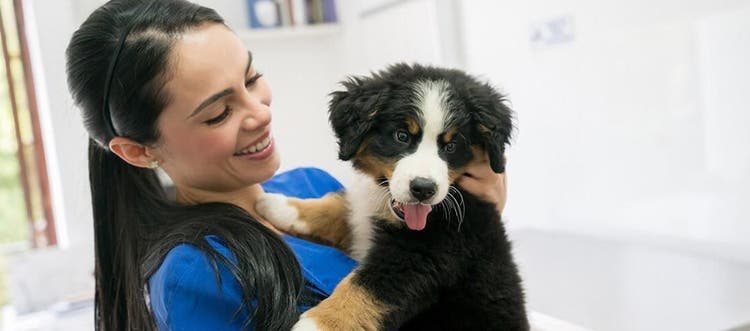Reviewed by Dr Sylvia Shortreed BVSc
If your dog is scratching more than usual, it could indicate a flea infestation. Find out everything you need to know about fleas and dogs.
What are fleas?
Fleas love dogs, but the feeling definitely isn’t mutual. These parasites can jump on your dog when he’s playing with other flea-infested pets or visiting places where flea-infested animals have been. They can also travel into your backyard or home on the fur of a visiting animal and find their way to your pet. They then stay alive by sucking your dog’s blood and can transfer diseases and parasites in the process.
In short, you don’t want fleas, and neither does your dog.
What do dog fleas look like?
There are about 2,000 varieties of fleas in the world, but the most common flea found on dogs is, surprisingly, the cat flea. Cat and dog fleas are only a few millimetres long. They appear brown or black in colour but are difficult to spot because they burrow deep into the fur and move fast.
It’s easier to detect fleas by checking for flea droppings, which you might see in your pet’s coat, especially at the base of their tail, or on their bedding as tiny black specks. Brush them with a bit of damp white paper and they will turn reddish brown.
What is a flea’s lifecycle?
Understanding the four main stages of the flea life cycle can help you effectively prevent and control infestations:
- Flea eggs: The cycle starts when a female flea lays tiny white eggs in your dog's coat, which later fall off and scatter throughout their environment.
- Larvae: Within a few days, the eggs hatch into maggot-like flea larvae that move away from light, burrowing deep into carpets, bedding, between floorboards, and under furniture while feeding on flea droppings and dead skin cells.
- Pupae: The larvae spin cocoons around themselves, entering a pupal stage where they develop into adult fleas, protected until the right conditions trigger them to emerge, or “hatch”.
- Adult fleas: Once hatched, adult fleas are hungry, and seek out hosts like your pet to feed on their blood and continue the cycle by laying more eggs.
Discover more about the flea lifecycle by checking out this informative video.
How do dogs get fleas?
If you've ever wondered how your beloved canine companion ends up with fleas, you're not alone. It can be puzzling when your dog suddenly starts scratching incessantly, and you're left trying to figure out the source of the pesky problem. Let's take a closer look at the ways dogs can get fleas and how these tiny invaders find their way into your home:
- Contact with other infested animals: One of the most common ways dogs get fleas is by interacting with other animals carrying these tiny parasites. Whether it's during playtime at the dog park, a visit to the groomer, or a chance encounter with a neighbour’s pet, close contact with an infested animal can easily transfer fleas to your dog.
- Infested environments: Fleas are expert hitchhikers and can jump impressive distances in search of a new host. Your dog can pick up fleas from infested environments such as parks, yards, or even your own home. Flea eggs left behind by flea-infested animals will hatch and develop through their life-stages into adults, whilst remaining hidden in the environment (eg.in grass, soil, carpet fibres). These hungry adult fleas will then infest a passing host like your dog.
- Wildlife visitors: Wild animals like possums, rodents, and feral cats can carry fleas and inadvertently introduce them to your yard. As these critters traverse your property, they can leave behind flea eggs, creating an infested environment that puts your dog at risk of picking up these unwelcome passengers.
- Human carriers: Though much less common, humans can also unintentionally transport fleas into your home. Fleas can hitch a ride on clothing, shoes, or other belongings, eventually finding their way to your dog.
Understanding how dogs get fleas is the first step in safeguarding your pet from these pesky parasites. By staying vigilant and implementing preventive measures, you can help keep your dog flea-free and ensure that they lead a comfortable, itch-free and healthy life.
What problems can fleas cause?
In addition to irritating your dog with bites, fleas can cause several health problems for your dog, and for you or your family.
Let's take a closer look at these health problems:
- Skin problems: Flea bites lead to itching and skin irritation and in some dogs can also result in flea allergy dermatitis (FAD). This allergic reaction to flea saliva can trigger intense itchiness and make your dog's skin red, swollen, and scabbed. Persistent scratching and biting may cause open sores that can become infected.
- Tapeworms: Dogs can contract flea tapeworms if they accidentally swallow infected fleas while grooming. These intestinal parasites can lead to an itchy bottom in dogs, and with very heavy infestations can lead to weight loss, vomiting, and diarrhoea.
- Bacterial diseases: Fleas can carry and spread bacteria between pets and people, potentially leading to serious diseases. One study discovered that 50% of fleas carried at least one disease-causing bacteria.1
- Anaemia: In extreme cases, a heavy flea infestation might cause anaemia in dogs. Anaemia results from a reduced number of red blood cells, causing symptoms such as weakness, lethargy, and pale gums. Left untreated, anaemia can be life-threatening.
- Emotional distress: The constant itching and discomfort from flea bites can lead to emotional distress in dogs, manifesting as behaviour changes like aggression, anxiety, and depression.
- Diseases in people: Fleas also bite humans, causing discomfort and leaving red spots that can be very itchy. More concerningly, people can become infected and seriously unwell as a result of flea-borne diseases (FBDs) such as bartonellosis and rickettsiosis. These FBDs pose a serious risk to human health and are caused by bacteria carried by healthy pets and transmitted to people via flea bites, or through contact with flea droppings when touching a flea-infested pet.
Keep in mind that some dogs may be more prone to flea-related health problems than others, and the severity of symptoms can vary based on the individual dog's health and immune system. Nonetheless, it's crucial to address any flea infestation promptly to prevent health issues, especially the spread of diseases to your pet, yourself and your family.
What can you do about fleas?
Fortunately, dog owners can choose from a wide variety of effective flea treatments to protect their dog and their home from these persistent pests. Find out more about flea treatment and prevention with our comprehensive review of dog flea treatments.
How can you prevent fleas?
There are many possible treatments for dogs, but prevention is always better than treatment. Here are some practical tips to help you keep fleas at bay and ensure your furry friend stays healthy and itch-free. These prevention methods can be used in conjunction with each other to maximise effect:
- Regular flea treatments: By far the most important strategy to prevent fleas on your dog is regular flea prevention treatment. We recommend using a product that suits you and your dog’s lifestyle. Flea protection can come in a variety of options such as the effective spot-on treatment AdvocateTM, or the monthly tasty treat, CredelioTM PLUS, or the long-lasting SerestoTM collar. These treatments help to keep fleas from infesting your dog and your home and can offer protection for varying durations. Be sure to follow the instructions on the labels for each product.
- Maintain a clean environment: If you're not using a flea control product that contain imidacloprid, regularly vacuuming your home and paying special attention to areas where your dog spends most of its time will help to remove flea eggs, larvae, and pupae from carpets, upholstery and floor cracks. Launder your dog's bedding, toys, and any washable items in hot water to kill any fleas or their eggs. However, if your flea control product contains imidacloprid (such as AdvocateTM, AdvantageTM, AdvantixTM and SerestoTM), these products will work to treat fleas in your dog's environment too! For the sake of you and your household guests, it's probably best to keep your house clean anyway, but these products will help take the stress out of cleaning your house meticulously to try to prevent fleas.
- Groom your dog: Regularly brushing your dog is a lovely way to bond with and pamper them, however no amount of brushing or combing will prevent or treat an active flea infestation. When large numbers of fleas are present, you may want to pre-treat your dog by bathing him with a shampoo containing an ingredient to kill adult fleas on contact. This is best done before applying a spot-on treatment such as AdvocateTM, which can be applied as soon as the coat is dried after bathing. If you prefer to use an oral flea treatment like CredelioTM PLUS, you can bathe your dog at any point before or after treatment.
By following these simple but effective preventive measures, you can help keep your dog flea-free and ensure they stay comfortable, happy, and healthy. Remember that it's much easier to prevent fleas from becoming a problem in the first place than it is to deal with a full-blown infestation.
1.Shaw SE, Kenny MJ, Tasker S, Birtles RJ, Vet. Microbiol. 2004 Sep 8;102(3-4):183-8. Pathogen carriage by the cat flea Ctenocephalides felis (Bouché) in the United Kingdom.









